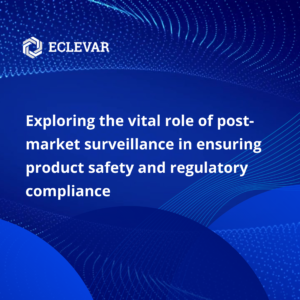What vital role does post-market surveillance play in ensuring product safety, regulatory compliance, and customer satisfaction throughout the journey?
Post-Market Surveillance (PMS) plays a crucial role in evaluating the safety and effectiveness of medical devices, beyond what can be determined through initial clinical trials. By collecting user data, analysing it, and taking appropriate action, PMS allows manufacturers to identify and address previously unknown risks associated with their devices.
It allows manufacturers to make necessary adjustments to the device’s design or manufacturing process, provide additional training to users, or even conduct post-market clinical follow-up studies to further evaluate its performance. Incorporating PMS as an integral part of the product lifecycle ensures ongoing monitoring and continuous improvement, enhancing the overall safety and effectiveness of medical devices.
Discover the critical importance of Post-Market Surveillance in the product industry. Explore best practices to ensure product safety, regulatory compliance, and customer satisfaction throughout their lifecycle.
The role of PMS
Post-market surveillance serves as a critical mechanism for manufacturers to gather information and assess the performance of medical devices that have been released into the market. By systematically collecting and evaluating the experiences and feedback from users, manufacturers can ensure the continued safety and effectiveness of their devices. If post-market surveillance identifies any risks that outweigh the benefits of using a particular medical device, appropriate actions can be taken to mitigate those risks.
The significance of this activity lies in its ability to capture real-world user experiences and feedback. Clinical trials provide valuable insights during the pre-market stage, but they are conducted in controlled environments with a limited number of participants.
Regulatory bodies, such as the FDA in the United States and the European Commission in the European Union, recognize the importance of PMS and have implemented regulations to govern these activities. Compliance with these regulations is crucial for manufacturers to meet the requirements set out by the regulatory authorities. As the emphasis on Post-Market Surveillance continues to grow, it is expected that more markets worldwide will adopt similar regulatory frameworks to ensure the ongoing safety and effectiveness of medical devices throughout their lifecycle.
Regulations for Post-Market Surveillance in the US
In the United States, PMS is regulated by the FDA’s 21 CFR part 822, which outlines the requirements for medical device manufacturers. The FDA mandates post-market surveillance for devices that have the potential to pose serious risks to health, as stated in Section 522 of the Federal Food, Drug, and Cosmetic Act. Manufacturers are required to comply with these regulations to ensure the ongoing safety and effectiveness of their devices.
The agency provides the MedWatch form system, a web-based portal that enables end users of medical devices to report any adverse events or non-conformities encountered during device use. Additionally, the FDA conducts its own post-market surveillance activities through Post-Approval Studies or 522 Post-Market Surveillance Studies. These measures ensure that potential issues and risks associated with medical devices are identified and addressed promptly.
There are specific cases in which the FDA may mandate post-market surveillance by medical device manufacturers. These include:
- Class II or III devices that have the potential to cause serious adverse health consequences upon failure
- Devices with widespread use in paediatrics
- Devices intended for long-term implantation in humans
- Devices intended for life-sustaining or lifesaving use outside of medical facilities
- Class I devices, which are considered the lowest risk, are typically exempt from the requirements.
Manufacturers ordered by the FDA to conduct surveillance have a limited timeframe of 15 months from the date of the order to initiate the required activities. They are required to submit a Post-Market Surveillance plan, including study objectives, design, and proposed schedules for interim and final reports.
Regulations for Post-Market Surveillance in the EU
The European Union’s Medical Device Regulation (MDR) of 2017 introduced a significant emphasis on Post-Market Surveillance for medical devices. Elements such as the development of a PMS plan, the establishment of procedures, and the submission of PMS reports (PMSRs) or Periodic Safety Update Reports (PSURs), are indicated by the regulation.
Unlike the United States, where PMS activities are primarily required for higher-risk devices that undergo premarket approval, the MDR applies to all medical device manufacturers selling within the European Union. Manufacturers must demonstrate that they have conducted Post-Market Clinical Follow-up (PMCF) or provide a justifiable reason for not doing so.
Article 83 of the regulatory guidelines outlines the fundamental requirements for the PMS system. The feedback gathered within the PMS system serves several important functions. It is utilized to update the benefit-risk assessment and enhance risk management strategies associated with the medical device. Additionally, the feedback helps in revising and improving the design, manufacturing information, instructions for use, and labelling of the device.
The PMS system also plays a crucial role in:
- Detecting reportable trends
- Updating the technical documentation
- Identifying necessary actions for preventive
- Corrective, or field safety measures
- Recognizing opportunities to enhance the usability, performance, and safety of the device
Creating a PMS system
Implementing a robust post-market surveillance (PMS) system is crucial for gathering data on the safety and performance of medical devices. To ensure an effective PMS system, proper planning is essential. This involves developing a comprehensive PMS plan and assigning responsibility to a dedicated quality manager or team member who will oversee the PMS activities. By establishing clear processes and channels, such as customer feedback, product complaints, and post-market studies, manufacturers can efficiently collect valuable data from users.
A PMS system should include some basic elements:
- Planning
- Data collection
- Data analysis
- Training
- Risk management
Post-market clinical follow-up studies (PMCF)
Post-Market Clinical Follow-up (PMCF) studies play a crucial role in evaluating the safety and effectiveness of medical devices once they have been released into the market. These studies become particularly important when there is limited initial data available, or concerns arise regarding potential risks associated with a device.
PMCF studies are typically required for devices that employ new medical technologies, present significant product-related risks, are used with vulnerable populations such as the elderly or children or necessitate examination of the device’s performance and safety in a more diverse user population than was studied during the initial clinical trials.
Trust Eclevar to support your device’s post-market surveillance
We have a team of advisory personnel with extreme knowledge and expertise in complying with regulatory demands during medical devices’ entire lifecycle. Contact us for partnering up and enhance your product safety with Post-Marker Surveillance activities.

